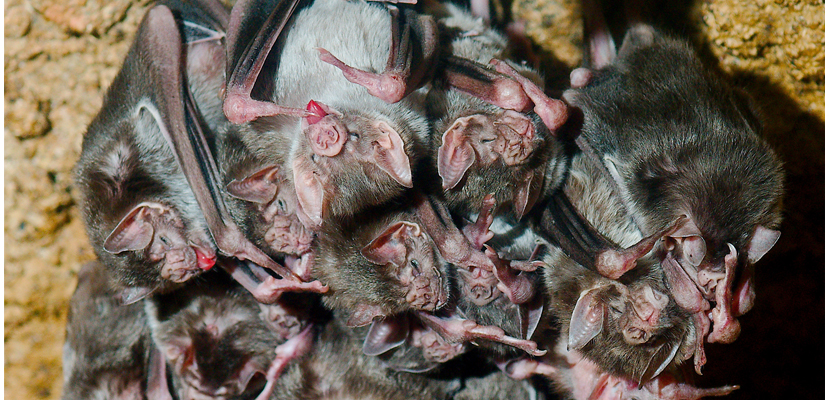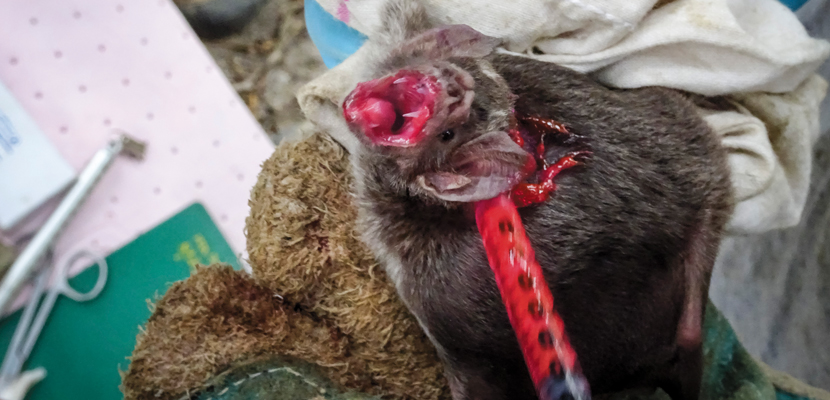Glow-in-the-Dark Vampire Bats Could Help Curtail Rabies
By Gabriela Serrato Marks
Oral vaccines could take advantage of these animals’ grooming behavior; test immunizations make them glow under ultraviolet light.
Oral vaccines could take advantage of these animals’ grooming behavior; test immunizations make them glow under ultraviolet light.

There is only one kind of mammal that survives solely on blood: vampire bats. These flying, biting creatures are some of the most feared animals—so Daniel Streicker has his work cut out for him when he tries to convince people that they’re worth saving. Streicker is an ecologist at the University of Glasgow who studies rabies in vampire bats, especially in South America. He’s quick to point out some striking features of these bats: “They share blood with one another, they hop around with remarkable agility for a bat, and they are so socially tuned in that you almost think that they are curious about what we’re doing when we catch them,” he says. Other researchers in this field sometimes call bats “sky puppies,” because they say the bats look like tiny, adorable puppies with wings.

Josh More/stories.starmind.org
Streicker’s research has important public-health implications: According to the World Health Organization, tens of thousands of people die from rabies every year. In Africa and Asia most transmission to humans occurs through dog bites, but in the Americas, bats are the major source of human rabies. In the South American towns where Streicker works, children are bitten frequently by vampire bats (although not every bite confers the disease). Even though post-exposure prophylactic treatment exists, it can be prohibitively expensive or unavailable. On top of that, the bats sometimes bite and infect livestock, which can be fatal for the farm animals. Streicker is trying to change that, but vampire bats are so different from other animals that transmit rabies that he can’t use methods that have been effective at curbing the disease elsewhere.
For decades, people have culled populations of vampire bats in their attempt to control the spread of this disease. Jasmin Camacho, a PhD candidate at Harvard University who is not involved in Streicker’s research, works with bats in Trinidad. She explains that during a culling operation, people smear poison on a bat’s fur and release it. “The bat flies back to its roost and other bats help clean it up. When the bats ingest the chemical, most commonly the blood thinner warfarin, they are killed,” Camacho says. These bats’ social behaviors, especially grooming, make them an easy target for such tactics.
Streicker and other bat researchers have found that culling is useful for reducing bat bites on humans and livestock but inadequate for rabies prevention, as he and colleagues report in a 2012 paper in the Proceedings of the Royal Society B. These findings are based on “decades of continued mortality from rabies, and in some cases intensification of rabies deaths, despite ongoing investments in culling bats,” Streicker says.
To find an alternative solution, Streicker’s first step was to figure out how the bats move, migrate, and spread the disease. Over the course of several years, Streicker and other bat researchers collected information on bat population genetics, movement patterns, and virus metagenomics in several parts of South America. He is using that data in computer models to predict where the next outbreak is likely to occur. The idea is to be proactive, addressing the problem before people get bitten. That’s because it’s hard to prevent bites from occurring. So Streicker’s team devised a plan to vaccinate the bats, which they hope will prevent rabies’ spread.

Kevin Bakker, University of Michigan
Catching individual vampire bats to study (or vaccinate) them is not very straightforward. “[Catching bats] is more challenging when you are interested in a particular type of bat,” says Camacho. “Some bats are in the forest and you need to set up nets, like a volleyball net, along the forest trails at night and wait for them to fly into it.” She also describes catching small groups of bats with a butterfly net. Although this approach could work on a small scale, it might not provide sufficient numbers of bats for vaccination to prevent rabies in a large bat colony—especially because they share blood meals.
Streicker is currently doing tests with a powder that uses a similar dissemination approach to the poison applied during culling. When the researchers catch a bat, they apply both an ultraviolet powder to the bat and a gel that, when ingested, makes hair glow under a special microscope. When the bat returns to its roost and is groomed, both substances can be transferred to other bats. Streicker’s team then observes the local bats to see how many are glowing in the ultraviolet light to test whether the powder is adequately spread. They also take hair samples to check whether the topical biomarker is ingested.
Eventually, he hopes to use a real, topically transmitted vaccine that works the same way. Bats in the most likely outbreak area would be vaccinated so they can’t infect people or livestock, but they wouldn’t have to be killed. Conserving vampire bats is a challenge because they are so despised, but Streicker has seen positive community support for his new ideas. Perhaps bat researchers won’t be the only ones calling these remarkable animals “sky puppies” much longer.
Click "American Scientist" to access home page
American Scientist Comments and Discussion
To discuss our articles or comment on them, please share them and tag American Scientist on social media platforms. Here are links to our profiles on Twitter, Facebook, and LinkedIn.
If we re-share your post, we will moderate comments/discussion following our comments policy.